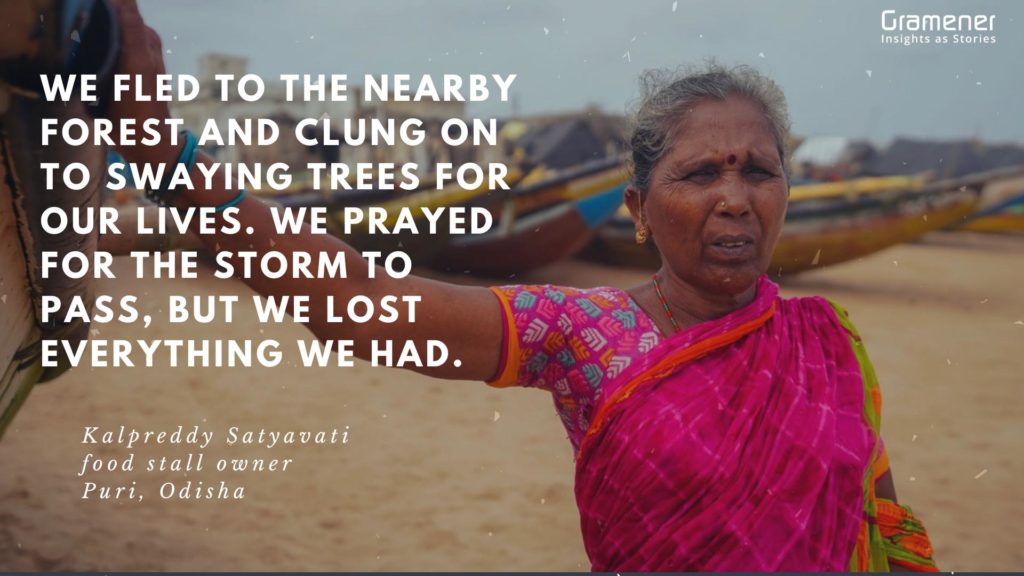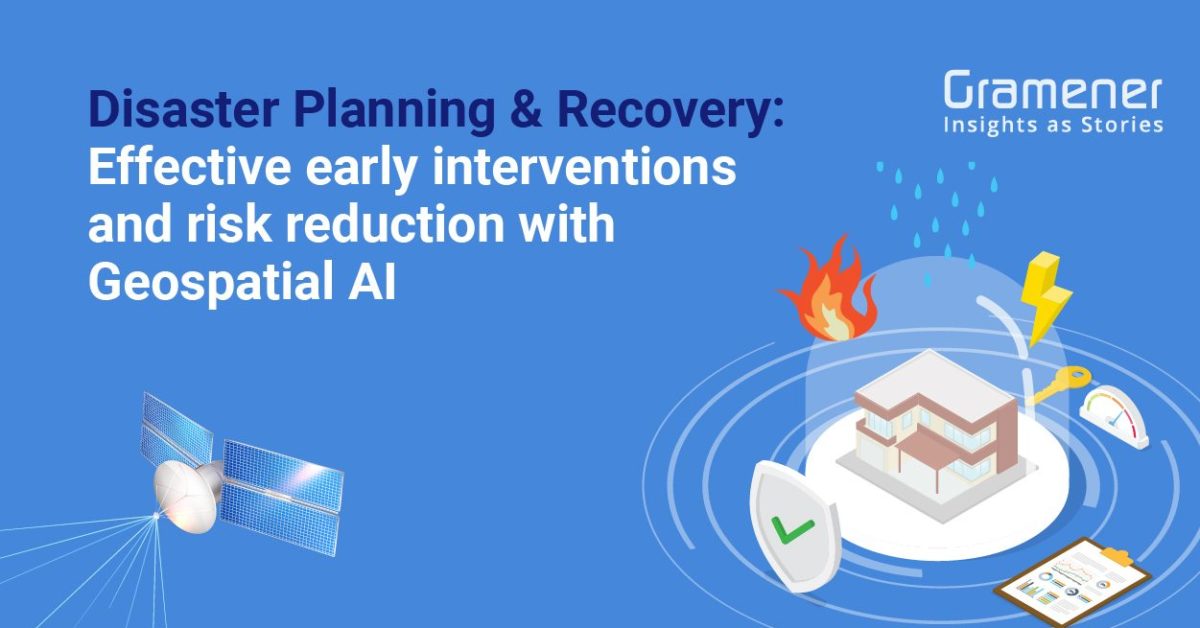In 2005, Hurricane Katrina killed nearly 1500 people in New Orleans when the flood prevention system of the city failed. The waters flooded 80% of the city and displaced 50% of the population. Some major efforts went into rebuilding the city. Had it been different, if AI or similar technology was used to do the disaster planning?
Yes! This is possible today with the voluminous availability of data. Multiple sources acquire weather data, land data, climate data, and more to predict insights related to natural disasters.
In this article, we’ll talk about how AI and big data can help nonprofits and researchers mitigate the risk of natural disasters. Also, we’ll share our impactful solution based on spatial analysis and satellite imagery that helped one of the leading non-profit clients protect vulnerable communities from the impact of climate change.

Table of Contents
What is a Natural Disaster?

Any naturally occurring physical phenomenon that disrupts humans and other life forms on earth is called a natural disaster. Earthquakes, wildfires, floods, hurricanes, tsunamis, heat waves, and droughts, are examples of natural disasters.
Severe heatwaves can lead to wildfires. The August 2009 wildfires of California devastated vast land regions and created dead plant build-up in the soil. Low humidity, dry tinder, and high temperatures cause wildfires, which is unusual for the month of August. Moreover, the difficult terrain made it difficult to provide relief to the area.
The 2004 Earthquake and Tsunami in the Indian Ocean is one of the deadliest natural disasters ever recorded in global history. It killed nearly 2.3 lakh people in 14 countries.
The coastal provinces of Aceh – Indonesia, Sri Lanka, Tamil Nadu-India, and Khoa Lak-Thailand were the worst hit in terms of loss of life, property, and economic activity. It took months to years in different countries to bring things back on track.
Globally, the unaffected countries and various international institutions provided financial and material help to rebuild these countries. Approximately US$14 billion came from worldwide donations.
While these maybe some of the biggest natural disasters, every year several natural disasters are causing a huge loss of life and property.
However, we can mitigate the effect of these disasters with the right technology. Such systems can help in the prediction of disaster events as researchers are now relying on AI-based systems to predict natural disasters.

The Role of AI to Combat Different Types of Natural Disasters
Countries across the globe are not oblivious to natural disasters. Different geographical regions are prone to different kinds of natural disasters. Here we will look at a few types of natural disasters and how researchers are deploying AI to predict them:
- Earthquakes: Perhaps one of the commonest and most heard of natural disasters is the earthquake. Seismic waves leads to earthquakes, which result from the activity in the earth’s lithosphere releasing energy. Now scientists are using AI-based seismic data to train AI systems. These systems can use Deep Learning models to understand seismic patterns, magnitudes, locations, and possibilities of aftershocks. Over 131,000 earthquakes have been studied by scientists up till now to create a neural network. This neural network was found to be more accurate than the traditional prediction systems in more than 30,000 events.
- Floods: Large amounts of rain, poor drainage systems, and some kinds of terrain can lead to floods which are another leading cause of damage to human life and activity. However, scientists are now using rainfall records and flood simulation exercises to create AI-based flood prediction systems. AI can monitor urban flood scenarios. Moreover, Twitter and other apps serve a great source of information to collect crowdsourced data to monitor urban floods.
- Hurricanes: Hurricanes are rotating storms with low-pressure centers with strong winds and spiral thunderstorms that can cause heavy rainfalls. Hurricanes can uproot lives, quite literally. This is why scientists want to create prediction systems for hurricanes. NASA and Development Seed monitored the recent Hurricane Harvey with the help of satellite images and Deep Learning models. The method used could track the hurricane hourly against the traditional six-hourly tracking. Such monitoring can help the AI systems to study patterns and predict future occurrences.
The Impact of Natural Disasters
Heavy industrialization and urbanization have led to a disruption in the environment which has increased the instances and impact of natural disasters. Life is unsettled at the individual, community, and economic levels:
- Individual-level: Natural disasters can cause significant loss and consequent trauma to individuals. Individuals can develop severe post-traumatic stress disorders. Many can withdraw into a shell. Many flee the city or country to supposedly safer environments.
- Community-level: Some natural disasters can change the entire geography of a place, uprooting whole communities. In some cases, communities have to migrate to different locations because it is impossible to re-start normal activity in the original place. Some communities, on the other hand, find opportunity in the face of disaster, become more cohesive, and rebuild strongly. Most communities, though, must pay attention to the mental and emotional health of individuals in the post-trauma period.
- Economic level: Hurricane Katrina left damages worth about $150 billion in its wake. The 2004 Tsunami in the Indian Ocean destroyed livelihoods in the coastal regions of several countries in that region, with a major impact on the fishery and tourism industries of the region. The 2009 California wildfires caused a minimum of US$134 million in damages. Not only do the damages of such natural disasters run in millions and billions, but they also rummage the economic activity for days, sometimes even months to a few years, in the regions where they occur.
Response of Disaster Management Agencies and Non-Profits to Natural Disasters
- Use conventional wisdom: Non-profit agencies gather and use conventional wisdom to provide relief to people affected during natural disasters. Communities come together to support individuals in solving problems through coordinated efforts.
- Use technology to accurately predict and plan: Local and national governments are increasingly investing in technology development for accurate prediction and disaster planning with AI. Disaster management agencies and non-profits use these technologies in relief work.
- Work on-ground with affected communities: The agencies and non-profits work at the community and individual levels to provide relief to those affected. They follow disaster recovery guidelines for the region and help in restoring, revitalizing, and redeveloping disaster-affected communities.
- Use tech to build disaster-resilient cities: Disaster management professionals use technologies to help in the restoration of cities after natural disasters. By using technology, it is possible to predict the extent and type of damage and hence, develop cities to withstand the damage. For example, Japan is highly earthquake-prone, and hence all construction there withstands earthquakes and minimizes damages.
Using AI for Disaster Recovery & Planning
Geospatial AI, such as Geographic Information System (GIS) technology can save lives and livelihoods from natural disasters.
In 2019 and 2020, India used GIS technology for better disaster planning and preparedness for cyclones such as Amphan, Hud Hud, Gaja, and Nisarga. GIS technology helps in enhancing the understanding of the environmental conditions, better decision-making, keeping tabs on the impacts of climate change, and deducing potential risk scenarios.
AI-based Deep Learning models use data from satellite imagery, disaster history, and weather reports to understand patterns and predict imminent disasters. These Deep Learning models use Convolutional Neural Networks (CNN) to draw insights and foretell potential occurrences. Integrating drones with Deep Learning applications provide real-time feed and can provide information for when an area will get hit by a disaster.
Gramener’s Contribution for Disaster Planning with Data & AI
Gramener partnered with Microsoft to develop an advanced machine learning-based solution that could help the client to create an effective intervention plan for natural disasters.
The model uses historical data and satellite imagery to predict hyper-local information. Early intervention and risk reduction could be utilized for this information.
Built on the knowledge garnered by the client over the course of many decades, the model can predict with granular accuracy which house will be most impacted by a flood in a specific community.
It maps information on satellite imagery and other geographic parameters. Further, we use it for generating early warnings and deploying preventive plans for high-risk individuals. Initially, we developed this model for floods, but now non-profit organizations can use it for other disasters such as heatwaves and earthquakes.
Conclusion
To sum up, disaster planning with AI is fast gaining ground because of the capabilities it brings to the table. Geospatial data such as weather reports, aerial photographs, IoT sensors, disaster statistics are used to improve disaster planning with AI. The accuracy and reliability of AI systems for disaster management can offer insights up to 2-3 years into the future. Such insights can better guide disaster preparedness and mitigate disaster impact.
Contact us for custom built low code spatial analytics solutions for your business challenges and check out ESG and AI solutions built for our clients, including Fortune 500 companies. Book a free demo right now.

